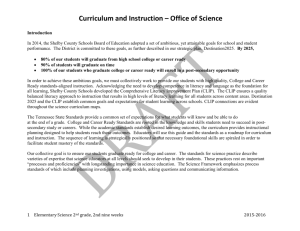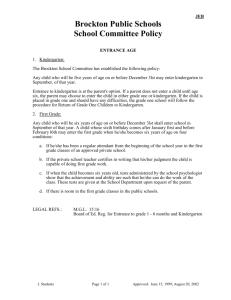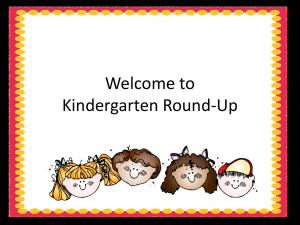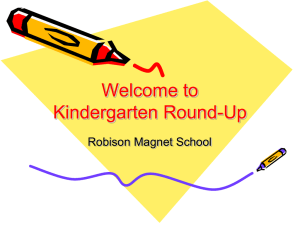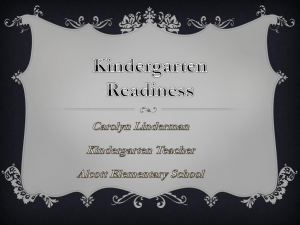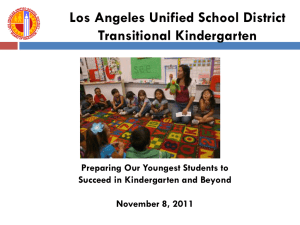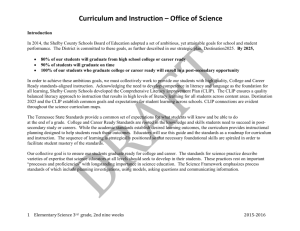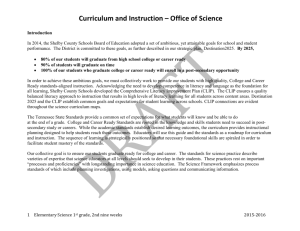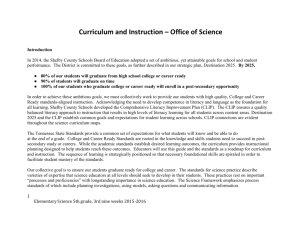Curriculum and Instruction * Office of Science
advertisement
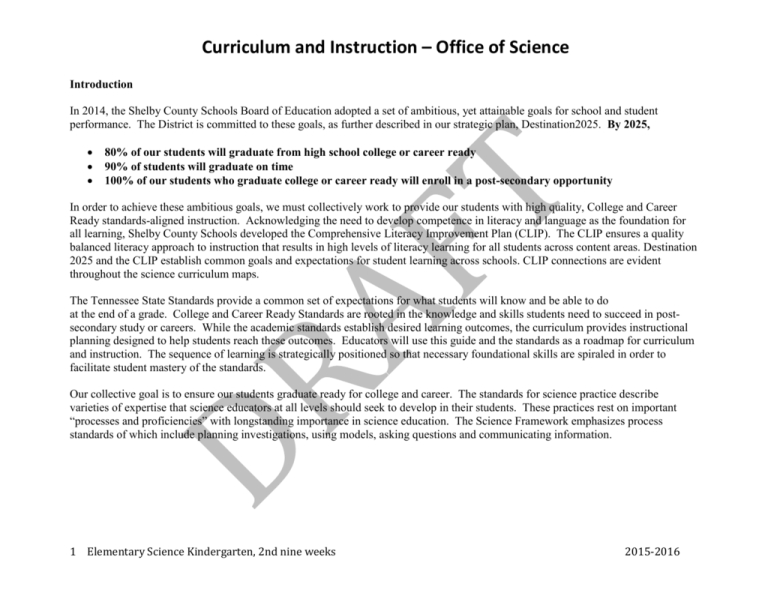
Curriculum and Instruction – Office of Science Introduction In 2014, the Shelby County Schools Board of Education adopted a set of ambitious, yet attainable goals for school and student performance. The District is committed to these goals, as further described in our strategic plan, Destination2025. By 2025, 80% of our students will graduate from high school college or career ready 90% of students will graduate on time 100% of our students who graduate college or career ready will enroll in a post-secondary opportunity In order to achieve these ambitious goals, we must collectively work to provide our students with high quality, College and Career Ready standards-aligned instruction. Acknowledging the need to develop competence in literacy and language as the foundation for all learning, Shelby County Schools developed the Comprehensive Literacy Improvement Plan (CLIP). The CLIP ensures a quality balanced literacy approach to instruction that results in high levels of literacy learning for all students across content areas. Destination 2025 and the CLIP establish common goals and expectations for student learning across schools. CLIP connections are evident throughout the science curriculum maps. The Tennessee State Standards provide a common set of expectations for what students will know and be able to do at the end of a grade. College and Career Ready Standards are rooted in the knowledge and skills students need to succeed in postsecondary study or careers. While the academic standards establish desired learning outcomes, the curriculum provides instructional planning designed to help students reach these outcomes. Educators will use this guide and the standards as a roadmap for curriculum and instruction. The sequence of learning is strategically positioned so that necessary foundational skills are spiraled in order to facilitate student mastery of the standards. Our collective goal is to ensure our students graduate ready for college and career. The standards for science practice describe varieties of expertise that science educators at all levels should seek to develop in their students. These practices rest on important “processes and proficiencies” with longstanding importance in science education. The Science Framework emphasizes process standards of which include planning investigations, using models, asking questions and communicating information. 1 Elementary Science Kindergarten, 2nd nine weeks 2015-2016 Curriculum and Instruction – Office of Science Construct explanations and design solution Obtain, evaluate, and communicate information Engage in argument Ask questions and define problems Patterns Develop and use models Practices in Science Use math, technology, and computational thinking Plan and carry out investigations Cause and Effect Stability and change Cross Cutting Concepts Analyze and interpret data Energy and matter Systems and system models Crosscutting concepts have value because they provide students with connections and intellectual tools that are related across the differing areas of disciplinary content and can enrich their application of practices and their understanding of core ideas. Throughout the year, students should continue to develop proficiency with the eight science practices. Crosscutting concepts can help students better understand core ideas in science and engineering. When students encounter new phenomena, whether in a science lab, field trip, or on their own, they need mental tools to help engage in and come to understand the phenomena from a scientific point of view. Familiarity with crosscutting concepts can provide that perspective. A next step might be to simplify the phenomenon by thinking of it as a system and modeling its components and how they interact. In some cases it would be useful to study how energy and matter flow through the system, or to study how structure affects function (or malfunction). These preliminary studies may suggest explanations for the phenomena, which could be checked by predicting patterns that might emerge if the explanation is correct, and matching those predictions with those observed in the real world. 2 Elementary Science Kindergarten, 2nd nine weeks 2015-2016 Curriculum and Instruction – Office of Science Science Curriculum Maps This curriculum map is designed to help teachers make effective decisions about what science content to teach so that, our students will reach Destination 2025. To reach our collective student achievement goals, we know that teachers must change their instructional practice in alignment with the three College and Career Ready shifts in instruction for science. To ensure that all student will be taught science content and processes in a comprehensive, consistent, and coherent manner, Science Curriculum Maps are provided. Foundation texts for the maps include Shelby County Schools Framework for Standards Based Curriculum, Science Curriculum Frameworks-K-12 (State of Tennessee Board of Education, and National Science Education Standards). Teachers function most effectively and students learn best within an “aligned” curriculum delivery system. An aligned system begins with a concerted effort to implement the state curriculum frameworks. Many districts have developed curriculum guides built around these frameworks to ensure that what is taught in particular grades and courses is closely linked with student Learning Expectations found in the state standards. Classroom teachers use these locally-generated curriculum guides to plan and implement their individual grade or course Pacing Guides. Expectations for student performance are clear and carefully tied to daily instructional events and classroom assessment practices. In theory, a fully aligned system closes the loop between state standards and student learning. Additionally, a coherent instructional/assessment system offers the potential for heightening student learning as reflected by their performance on state-mandated standardized tests. Our collective goal is to ensure our students graduate ready for college and career. Most of the elements found in the state Curriculum Frameworks were incorporated into the curriculum mapping materials prepared by Shelby County Schools. Additional features were included to add clarity and to offer avenues that could assist teacher in developing grade level lessons. A district-wide, K-12, standards-based curriculum is implemented in science. This curriculum is articulated in the form of individual SCS curriculum maps for each grade and subject. These SCS curriculum maps enable the district to implement a single curriculum that emphasizes specific standards. Since Shelby County has a high rate of mobility among the student population, the SCS curriculum maps ensure that all students receive the same program of high-level instructional content and academic expectations, regardless of which school they attend. The utilization of a district-wide standards-based curricular program ensures that students in SCS are engaged in hands-on inquiry based activities as teachers implement the curriculum maps. 3 Elementary Science Kindergarten, 2nd nine weeks 2015-2016 Curriculum and Instruction – Office of Science Kindergarten 2nd nine weeks Focus: Life Science Unit K.1.1 Standard: Heredity (Cell Structure and Functions) (Text in blue are hyperlinked to suggested resource) Time Frame (5 Weeks) I Can Statements: I can observe plants and observe animals change as they grow. I can match pictures of offspring with the adult such as seeding with a grown plant, child to parent, calf to cow, etc. Also, write the names of each when identified. I can keep and illustrated record of how plants change as they grow seed to adult using of measure. Standards 0007.4.1 - Observe how plants and animals change as they grow. 0007.4.2 - Observe that offspring resemble their parents. Learning Outcomes Observe the world of familiar objects using the senses and tools. Ask questions, make logical predictions, plan investigations and represent data. 2 Elementary Science Kindergarten, 2nd nine weeks Tasks & Resources MacMillan/McGraw-Hill: A Closer Look Grade K Unit A: Plants Parts of Plants Lesson 1: pgs. 24-29 What Plants Need Lesson 2 pgs. 34-39 How Plants Grow Lesson 3: pgs. 42-45 Teacher’s Edition: Unit A, TE pp. 40 -45, and Unit B TE How babies Grow, Growing Animals pp. 104 -111. Lesson 6 & 7 106-112 Compare and contrast animals and people pg. 112 CLIP Connection Academic vocabulary root, stem, leaf, air, light, water, soil, seed, seedling, fruit, flower, vegetable Literacy Connections How plants work Students, with guided support from the teacher, will read the passage. Students will use details in the passage to answer text dependent questions that focuses on how plants work. 2015-2016 Curriculum and Instruction – Office of Science 3 Elementary Science Kindergarten, 2nd nine weeks How plants get food and water - Students, with guided support from the teacher, will read the passage. Students will use details in the passage to answer text dependent questions that focuses on how plants get food and water. Invite children to circle the parts of the plants using a dry-erase marker. Write labels for the parts to help children revisit these terms while reviewing the life cycle. Count the number of times the word look appears in the first stanza of the poem on page 6. have them help you count the number of letters in the word look. Point to the word some each time it is read to help the students notice a pattern. Provide a blank piece of paper divided into five 2015-2016 Curriculum and Instruction – Office of Science parts. Tell a brief story of the life cycle of a pumpkin. Have students draw a picture of what the pumpkin plant looks like at each stage of growth. Additional Unit K.1.1 Online Resources Online Resources Video from Curious George plants http://pbskids.org/curiousgeorge/video/td/video_pop.html?clip=td/105B&title=Paper%20Towel%20Plants&ar=16:9&cc=true&filetype=mov&bandwidth =_hil Lesson plan for Curious George plantshttp://www.pbslearningmedia.org/resource/lsps07.sci.life.oate.lpexploreplant/exploring-plants/ Lesson including writing on concepts of living and nonliving things by developing their own definitions. video https://drive.google.com/open?id=0BzKKfABeY_s3aV9HU1h6cWtDRW8 Lesson on what animals need to stay alive http://lessonplansource.com/living-and-non-living-things-whats-alive/ Pink Palace Museum Outreach Suitcase Exhibits: (free) Magnifiers, Plant Reproduction, Trees & Leaves Passports: ($10/topic) Tree Cookies, Leaves & Seeds Lichterman Nature Center Field Trips Exhibits: Seasons, Life Cycles Programs: In Your Backyard Nature 2U: Plants: From Seed to Table 4 Elementary Science Kindergarten, 2nd nine weeks 2015-2016 Curriculum and Instruction – Office of Science Kindergarten 2nd nine weeks Unit K.2.2 Focus: Life Science Standard Characteristics (plants and Animals) (Text in blue are hyperlinked to suggested resource) Time Frame: 4 Weeks I Can Statements: I can compare and contrast the basic features of a variety of plants. I can compare and contrast the basic features of a variety of animals. Standards 0007.5.1 - Compare the basic features of plants and animals Learning Outcomes Observe plants and animals and make records of their similarities and differences. Explain the data from an investigation. Observe a plant to identify how it changes as it grows from a seed to the adult plant and record data using nonstandard measurement devices. Tasks & Resources CLIP Connection Macmillan/McGraw-Hill (2010) A Closer Look /Kindergarten Academic vocabulary animal, habitat, shelter, space, reptile, snake, lizard, mammal, wings, fins, food, insect, animal features, reef, skin, fur, scales, shell, feathers, grow, change, farm, beekeeper, growth, parent, egg Unit A Lesson 4 Look at Leaves and Flowers Sorting plants Pgs TE 4652 Unit Theme-Learn about Plants: pgs. 52-57, 58-69 Unit Theme—Learning about Animals: pp.88-9, 94-95, 96-107 Lab activities 5 Elementary Science Kindergarten, 2nd nine weeks Leaf rubbings- gather a variety of different leaves. pg. 53 TE Create a park including Literacy Connections All kinds of plants - Students, with guided support from the teacher, will read the passage. Students will use details in the passage to answer text dependent questions that focuses on the variety of plants. Animals build homes - Students, with guided support from the teacher, will read the passage. Students will use details in the passage to answer text dependent questions that focuses on the different types of animals 2015-2016 Curriculum and Instruction – Office of Science flowers, trees, bushes, etc… Music/ Take a Look Science songs p. TE TR24 Animals Need pg TR25 and how they build their homes. Additional K.2.2 Online Resources Online Resources www.scssciencedepartment.weebly.com password: energy Lesson on the Needs of Living Things http://www.teachersdomain.org/resource/tdc02.sci.life.colt.lp_stayalive/ Book for purchase Learn more with Plants and Animals (Real World Science) by Richard Hantula Gareth Stevens,2005 Books for purchase Learn more with Animal Babies by Harry McNaught Random House, 1977 Pink Palace Museum Field Trips Exhibits: Adaptations, Insects, Mid-South Mammals Labs: Journey to the Poles, Dinosaurs & Fossils CTI Theater: Flight of the Butterflies 3D, Humpback Whales 3D, Walking with Dinosaurs: Prehistoric Planet 3D Suitcase Exhibits: (free) Dinosaurs, Magnifiers, Skulls/Predator & Prey, Trees & Leaves Passports: ($10/topic) Weddell Seals, Sharks, Tree Cookies, Leaves & Seeds Lichterman Nature Center Field Trips Exhibits: Urban Wildlife, Adaptations, Seasons, Life Cycles, Backyard Wildlife Center Programs: Habitat Detectives, In Your Backyard, Wild Lunch, Animals Alive! Nature 2U: 11 topics including Amphibians: the Original Transformers, Going Batty; Birds-Our Feathered Friends; Beautiful Butterflies, Marvelous Mammals; Reptiles: Scales & Scutes, Plants: From Seed to Table; Poking in the Pond; Spectacular Spiders; Nocturnal Animals, Creepy Crawlies 6 Elementary Science Kindergarten, 2nd nine weeks 2015-2016


